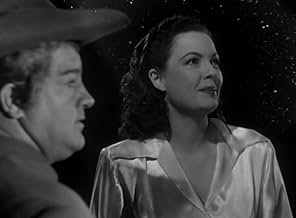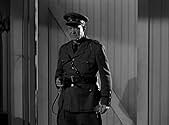IMDb RATING
7.5/10
3.8K
YOUR RATING
A psychiatrist stays in a mansion haunted by prankish ghosts from the Revolutionary War.A psychiatrist stays in a mansion haunted by prankish ghosts from the Revolutionary War.A psychiatrist stays in a mansion haunted by prankish ghosts from the Revolutionary War.
Lynn Baggett
- June Prescott
- (as Lynne Baggett)
Ann Gillis
- Nora O'Leary
- (as Anne Gillis)
Robert Barrat
- Maj. Putnam
- (as Robert H. Barrat)
Kirk Alyn
- Dandy at Party
- (uncredited)
Harry Brown
- Second Sergeant
- (uncredited)
George M. Carleton
- Museum Guard
- (uncredited)
Wheaton Chambers
- Bill - Museum Guard
- (uncredited)
James Conaty
- Party Guest
- (uncredited)
Storyline
Did you know
- TriviaWriting in the "Saturday Evening Post" in 1949, Bud Abbott said this was his favorite film role, because for a change he was the butt of all the punishment, instead of Lou Costello.
- GoofsIn the prologue, set in 1780, Horatio Prim (Lou Costello) uses the term "teetotaler" to say he doesn't drink alcohol. The term (short for "total temperance") didn't exist until the late 19th century.
- Quotes
Mildred Dean: [to Emily] Pardon me, but did I see you in "Rebecca?"
- ConnectionsFeatured in Svengoolie: The Time of Their Lives (2016)
- SoundtracksMinuet
(uncredited)
from "String Quintet in E Major, Op.13 No.5"
Written by Luigi Boccherini
Played as dance music at the party
Also played on a harpsichord and as background music
Featured review
Most fans of Abbott & Costello, if they don't consider THE TIME OF THEIR LIVES the best film they made consider it among the best films they made. It is an unusual film - their is some interplay between the two in the 18th Century sequences, where Abbott's Cuthbert plays his normal bossy and unscrupulous acquaintance to Costello's patriotic Horatio. To add to their normal problems with each other, they both like the same servant girl. Horatio has one prized possession - a letter from George Washington praising his patriotism. Unfortunately, the servant girl's employer is a large landowner who is a traitor (and a member of Benedict Arnold's conspiracy). The landowner has a girlfriend named Melonie, played by Marjorie Reynolds (probably her best remembered role after Bing Crosby's girlfriend in HOLIDAY INN). Melonie is momentarily in control of the letter, but her boyfriend takes it and hides it inside an expensive clock. Then the patriots arrive - Major Andre has been captured and the conspiracy revealed. Everyone flees, but Costello and Reynolds are shot and killed before they get away. A curse is put over their remains in their grave on the estate that (mistakenly considered) traitors they are doomed to be forever at unrest there.
The ghosts of the two find they literally are stuck their (the special affects are good - they accidentally run through each other and find they are wearing each other's clothing). They see a sign that reveals the curse that was unfairly put on them. Both know if the letter is found they would be released. But time passes. They don't know where the note is, or how to get to it.
Comes the 20th Century and Binnie Barnes, Abbott, and John Shelton show up - Abbott a descendant of the 18th Century scoundrel. They are planning to turn the old estate into an inn. Costello, with two centuries of bile and anger building up in him, torments Abbott (in this film Costello maintains the whip hand for a change). Gradually, with the aid of medium Gale Sondergaard, they learn what happened. And Abbott decides to redeem his family name by freeing the ghosts.
It is surprising that the Arnold Conspiracy is the only incident of the American Revolution that seems to have been properly handled in the movies, both here and in the later THE SCARLET COAT. But that was a more in depth look at the tragedy and heroism of Major John Andre. Here the Arnold conspiracy, while the motor for the plot, is only shown in the first twenty minutes of the film (then it goes modern), and the film (for all the tragedy for Costello and Reynolds in their rightful lifetimes) is mostly comic. The antics of the pair, in particular Costello's campaign against the hapless modern Abbott, is funny - living up to the first part of the pun of the title. For all their anguish at being cursed unfairly, the two ghosts get to enjoy themselves - they do have the time of their lives. The other half of the pun, of course, deals with the key to their salvation: that all important letter - hidden inside an 18th Century timepiece.
The ghosts of the two find they literally are stuck their (the special affects are good - they accidentally run through each other and find they are wearing each other's clothing). They see a sign that reveals the curse that was unfairly put on them. Both know if the letter is found they would be released. But time passes. They don't know where the note is, or how to get to it.
Comes the 20th Century and Binnie Barnes, Abbott, and John Shelton show up - Abbott a descendant of the 18th Century scoundrel. They are planning to turn the old estate into an inn. Costello, with two centuries of bile and anger building up in him, torments Abbott (in this film Costello maintains the whip hand for a change). Gradually, with the aid of medium Gale Sondergaard, they learn what happened. And Abbott decides to redeem his family name by freeing the ghosts.
It is surprising that the Arnold Conspiracy is the only incident of the American Revolution that seems to have been properly handled in the movies, both here and in the later THE SCARLET COAT. But that was a more in depth look at the tragedy and heroism of Major John Andre. Here the Arnold conspiracy, while the motor for the plot, is only shown in the first twenty minutes of the film (then it goes modern), and the film (for all the tragedy for Costello and Reynolds in their rightful lifetimes) is mostly comic. The antics of the pair, in particular Costello's campaign against the hapless modern Abbott, is funny - living up to the first part of the pun of the title. For all their anguish at being cursed unfairly, the two ghosts get to enjoy themselves - they do have the time of their lives. The other half of the pun, of course, deals with the key to their salvation: that all important letter - hidden inside an 18th Century timepiece.
- theowinthrop
- Jan 25, 2006
- Permalink
Details
Box office
- Budget
- $830,000 (estimated)
- Runtime1 hour 22 minutes
- Color
- Aspect ratio
- 1.37 : 1
Contribute to this page
Suggest an edit or add missing content

Top Gap
By what name was The Time of Their Lives (1946) officially released in India in English?
Answer





































